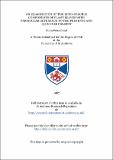Files in this item
An examination of the lipid-soluble components of plant leaves with particular reference to the pigments and quinones present
Item metadata
| dc.contributor.advisor | Tristram, George Roland | |
| dc.contributor.author | Bond, Colin Peter | |
| dc.coverage.spatial | 236 p. | en_US |
| dc.date.accessioned | 2018-06-21T13:59:34Z | |
| dc.date.available | 2018-06-21T13:59:34Z | |
| dc.date.issued | 1967 | |
| dc.identifier.uri | https://hdl.handle.net/10023/14407 | |
| dc.description.abstract | 1) The literature covering the fields of isoprenoid quinones, leaf carotenoids and gradient elution chromatography has been comprehensively reviewed, the latter with particular reference to the methods available for the production of concentration gradients. The literature concerning the other lipid components of the chloroplast, together with the role of lipids in photosynthesis, has also been reviewed, although to a lesser extent. 2) A system for the production of complex concentration gradients has been devised, based on the use of a multi-chamber apparatus with the chambers connected in series by means of pumps. With the aid of the Computer Laboratory, the gradients produced by such a system have been examined and some general principles governing such gradients have been discussed. 3) The gradient producing system above has been used in the development of a semi-automatic, gradient elution chromatographic assay method for the plant quinones, and this method has been used to study the variation of these quinones throughout the growing season. This method appears to be more accurate and reproducible than those at present in use, as well as achieving more rapid analysis. 4) Thin layer chromatography has been used, in both adsorbent and reversed phase applications, together with reversed phase paper chromotography, to examine the caroten-oids and guinones present in leaves. Various other lipids present have also been studied, including the plant chromanols. 3) A thin layer technique for the separation of leaf carot-noids has been developed from 4) above and this, combined with spectrophotometry, has been used as a rapid assay method for the detection and estimation of the leaf carotonoids. 6) The development of carotenoids, chlorophylls and quinones on illumination of etiolated tissue has been-examined, using the techniques summarised in 3) and 5) above, together with a standard spectrophotometric assay the chlorophylls. | en_US |
| dc.language.iso | en | en_US |
| dc.publisher | University of St Andrews | |
| dc.subject.lcc | QK865.B7 | en |
| dc.subject.lcsh | Botanical chemistry | en |
| dc.title | An examination of the lipid-soluble components of plant leaves with particular reference to the pigments and quinones present | en_US |
| dc.type | Thesis | en_US |
| dc.contributor.sponsor | British Glues and Chemicals Limited | en_US |
| dc.contributor.sponsor | University of St Andrews | en_US |
| dc.type.qualificationlevel | Doctoral | en_US |
| dc.type.qualificationname | PhD Doctor of Philosophy | en_US |
| dc.publisher.institution | The University of St Andrews | en_US |
This item appears in the following Collection(s)
Items in the St Andrews Research Repository are protected by copyright, with all rights reserved, unless otherwise indicated.

